Now & New
- Experience
Friendship Day at MCAS Iwakuni: Closest US Soil to Hiroshima
The United States and Japan have had close military ties ever since the end of World War II, due largely in part to the Cold War but also due to the fact that Japan has not a traditional military, but Self-Defense Forces instead. Today, the United States Armed Forces maintains bases all over Japan, most of which are located in East Japan and Okinawa. For better or worse, there are no US military facilities in Hiroshima Prefecture, but Hiroshimarians still have the pleasure of easy access to the Marine Corps Air Station (MCAS) Iwakuni just over the prefectural border. Back then, any US citizen could waltz into the base by showing his or her US passport, but nowadays, MCAS Iwakuni is only open to civilians—American or not—on Friendship Day, which typically takes place over Golden Week. Since I was almost always on vacation elsewhere during that period, I was never able to make it to Friendship Day, but as it was held on the 15th of April this year, this would be the first chance for me to get a taste of American culture in Japan.
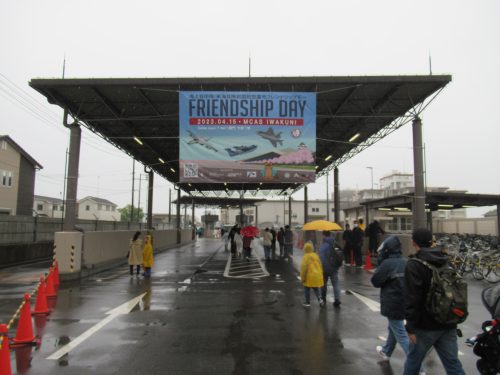
This year’s Friendship Day was the first held since 2019, the 44th one held in total, and just so happens to mark the 50th anniversary of the first Friendship Day back in 1973. In spite of the dreary weather that day, thousands of visitors were intent on paying MCAS Iwakuni a visit to buy exclusive American foodstuffs and to see US fighter aircraft in action. The doors opened at 7:00 a.m., but I couldn’t be bothered to get there that early in the morning, so I instead took a train from Hiroshima Station that got to Iwakuni Station around half past nine. There were busses shuttling visitors between the station and base, but also monster lines so long that walking there would be faster than waiting. MCAS Iwakuni wasn’t at all difficult to reach or find: simply walk south of Iwakuni Station and over a bridge, then follow a bunch of pedestrians who obviously have a common destination. Although everyone is welcome onto the base during Friendship Day, an ID of any nation is required to enter, and after the Marines checked my identification and thoroughly checked every pocket of my bag, I was waved in and given the green light to enjoy the festivities until the base closed its doors at 18:00.
The American Bubble
I had friends in Japan who visited this base long before I did and described it as “a suburban American bubble,” and that description could not be any more fitting. Even though the parts of the base we were allowed to see that day were limited, I saw the parking garages, apartment complexes, and wide-open streets with street names on signs, all of which screamed American suburbia to me. What’s more, just for today, they had tents all over the festival site selling American snacks, drinks, pizza, ice cream, and other familiar foods imported from the Land of the Free.
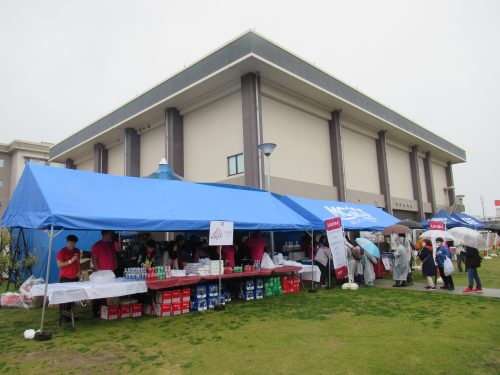
Some folks step onto the base just to buy these foodstuffs and take them straight home without participating in any other aspect of Friendship Day. Naturally, because MCAS Iwakuni is US soil, customers can buy anything on base with either US dollars or Japanese yen, but the exchange rates were all over the place and arbitrarily determined, differing between shops and even between items at the same store. I was wise to bring cash in both currencies and crunched numbers hardcore before making any purchase in order to game this haphazard system.
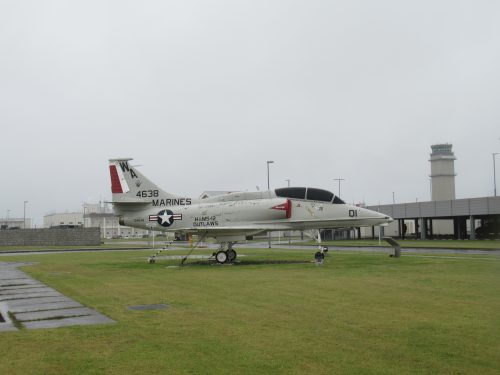
As I stepped deeper into the base, I started seeing parked war machines on display, as well as a gated-off runway where real US Marine fighter planes were taxiing. Most of the stationary vehicles were staffed by servicemen who let visitors take pictures with the cars, tanks, planes, and helicopters, though some were roped off and couldn’t be approached. These same Marines were also happy to pose in photos with the tourists or act as the cameramen, which is where the “friendship” in Friendship Day comes from.
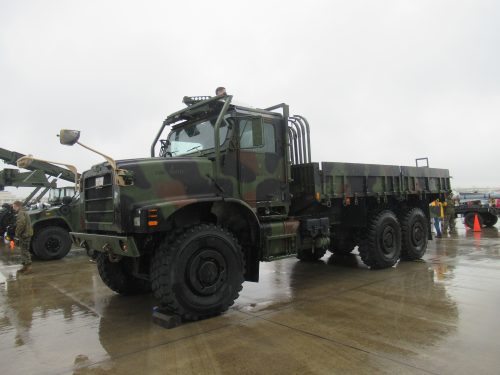
Take to the Skies
As I walked through the lot and around the hangars, trying to avoid bumping into people’s umbrellas and stepping in some rather deep puddles, I could hear the air show in the distance. I looked at the sky and saw a rescue helicopter performing its standard operating procedure for saving people, but the show was over by the time I got to the viewing area so this zoomed up photo was all I got. Since the aircraft are high up in the sky and make a huge racket when flying, visitors can technically see the air show from many sites on the base, but the best action is obviously to be caught close to the runway, where a paid viewing area for official journalists (not me) or the most die-hard fans (also not me) with benches can be accessed for an astronomical fee. I decided to stand in the free viewing area next to the entrance to the paid area, and still got some decent footage of these daring pilots.
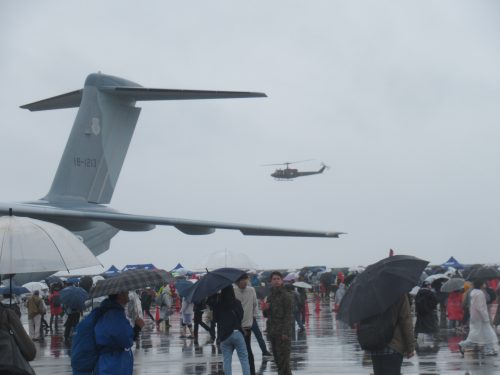
A majority of the flight demonstrations were either postponed or outright canceled for the day on account of the rain, but my timing was just right to catch famed aerobatic pilot Yoshihide Muroya strut his stuff. “Yoshi,” as he is commonly referred to, wowed the crowd with stunts that made his viewers dizzy, all the while leaving behind a mesmerizing trail of smoke. He was fast indeed, but still not hard to follow with my camera.
International Carnival Fare
After watching Yoshi’s performance, I backtracked to the first area where the majority of the food stands and display vehicles were. In addition to food vendors, there was also the occasional tent selling military memorabilia featuring the livery of the US Marines or the Japan Air Self-Defense Force. Interestingly, the shoppers most interested in that merchandise seemed to have no connection to either military body, but bought stuff because they were just that enamored with airplanes.
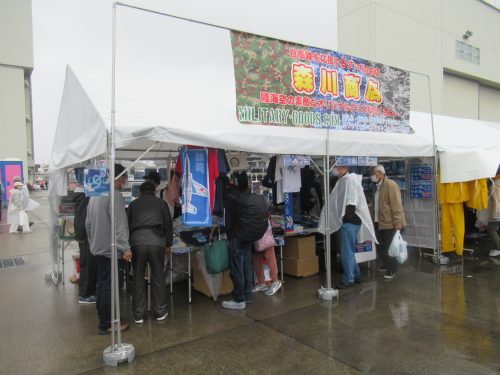
However, I was hungry for carnival fare, not goods, so I wandered to the other end of the lot where a world’s fair of festival foods was on tap. The Japanese staple items included candied fruit, wagyu beef skewers, shaved ice, and Sasebo burgers, but in between those stands were Korean corn dogs, American fried chicken, and a slew of other ethnic delicacies. Stands run by American accepted cash payment in both Japanese yen and US dollars, but JPY coins smaller than ¥100 were not taken, and no USD coinage was accepted at all.
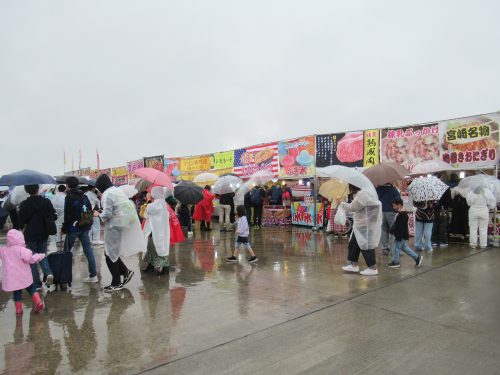
The first stand I decided to eat from was the one offering barbecue, which evoked memories of Texas. They had pork spare ribs, beef brisket, and pulled pork, available a la carte or as combos (paired with corn on the cob or a bag of chips). Additionally, they were grilling burgers and hot dogs right before people’s eyes, selling them individually or as combos with the choice of a soft drink or a bag of chips. Everything looked tempting, but as I planned on eating a lot more that day, I went for a humble beef brisket sandwich as a nod to the Lone Star State. To be frank, the lack of flavor or moisture of the brisket left a bit to be desired, but being all the way in eastern Yamaguchi Prefecture, I was grateful to even have this nostalgic food in the first place.
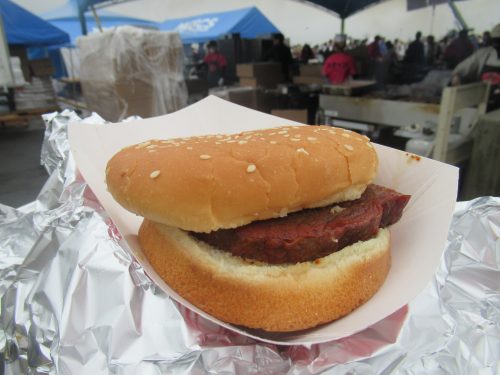
As for my side order, rather than have a dinky corn on the cob, I searched for something more meaningful from another food stall. After a couple rounds of combing through my options, I shifted from Southern cuisine to a dish with Southwestern flair: a bowl of elotes (corn kernels) seasoned with black pepper, mayonnaise, and Hot Cheetos crumbs. I loved the vibrant colors in the dish and it tasted marvelous, but when the elotes are mixed, they turn this grotesque shade of pink that would probably turn off the average Japanese diner (they have this phobia of food coloring).
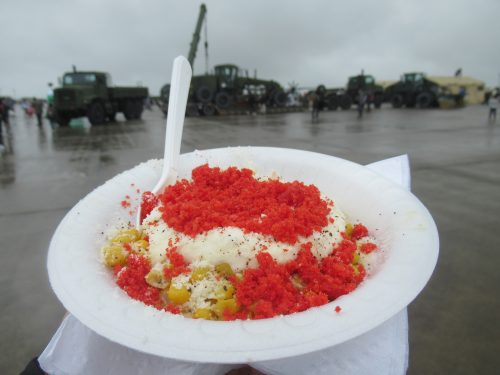
Rather than eat while walking around the grounds of the base, most guests that day picked a spot by one of the hangars to eat and drink, as did I. My preferred spot was actually a yellow, plastic barricade behind the tent serving barbecue, where it was easy to hear and sometimes see the supersonic fighter planes with their roaring engines. I was still a teensy bit hungry after my brisket sandwich and spicy corn, and feeling a bit thirsty too, so I returned to the food stalls for one last side order.
Moment of Joy: Cloud Nine Nostalgia
Each time I walked by any stand selling American snacks or soft drinks, a sonic boom of nostalgia hit me in the feels, reminding me of when I used to enjoy said products as a child or teenager. Out of all the familiar sodas, though, the one that truly hit home was Mountain Dew Code Red, which I immediately snatched up alongside a jumbo plate of fries and took back to the corner with the barrier.
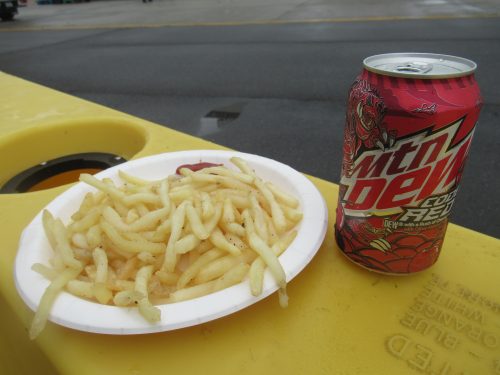
It truly was a shame that MCAS Iwakuni doesn’t let US citizens onto the base willy-nilly anymore, because after today, I felt a strong urge to return for the food and drink products that I sometimes crave when I live in Japan. If anything, that feeling could just translate into a promise to attend the next Friendship Day for that cloud nine feeling of nostalgia.
Welcome Aboard
Following the barrage of American food, there was but one thing left for me to do at Friendship Day, and that was to tour one of the military aircraft. I joyfully stepped into line, thinking I would soon be on board, but much to my dismay, that wait took forever and a day, and the rain started picking up again while we were exposed to the elements. Then again, it was also at that time that I heard one announcement after another confirming the cancellation of air shows for the rest of the day, so I suppose I was doing something right by waiting here.
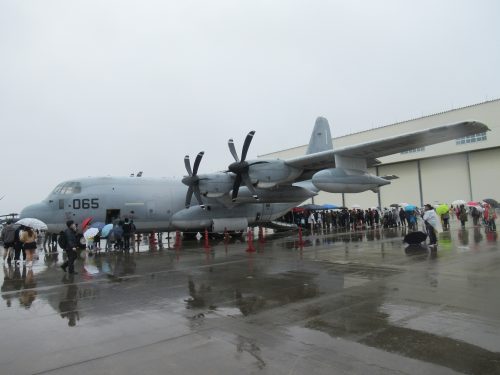
At long last, I made it up the ramp and into the back of the airplane’s cargo bay. There was pretty much nothing inside except harnesses, cables, and retractable seats, and yet the line inside the plane seemed to advance in slow motion. Like a light at the end of a tunnel, a staircase entered my sights and it dawned on me why it took so long for everyone to finish touring this behemoth.

The staircase led not to a second floor, but the cockpit, where visitors sat in the seats while a pilot took photographs of them with their own cameras. He and I actually had some interesting banter (after I finally revealed that I’m not Japanese) about our past lives back Stateside, and it felt refreshing to connect with someone new in Japan with whom I shared common ground. With my pictures all taken, I carefully stepped down and out of the aircraft, but not before a Japanese woman waiting outside inquired about the time it took to see the interior. I told her not to get her hopes up, then proceeded back to the front entrance of the base.
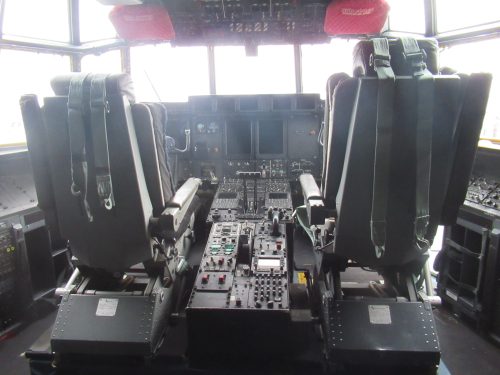
Back where the first food tents were, I purchased an ice cream sandwich to devour on the spot before saddling up for Iwakuni Station. Unlike the other snacks and drinks that I bought that day, this specific brand of American ice cream was one I had never eaten in my life, and yet, it looked and tasted familiar. Friendship Day was coming to a close at that point and they were about to stop food sales, so I counted myself lucky I was able to try this thing.
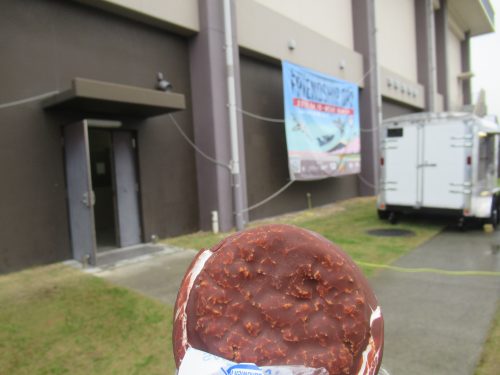
Suddenly, a miracle happened as I was about to leave the base. In order to get rid of all their pepperoni pizzas, the vendors announced a Buy One, Get One sale that I exploited at Mach 1. The two pizzas I bought lasted me three square meals over the following days when I went home, and were an unmatched deal considering that I didn’t have to tip anybody like they do in the States.
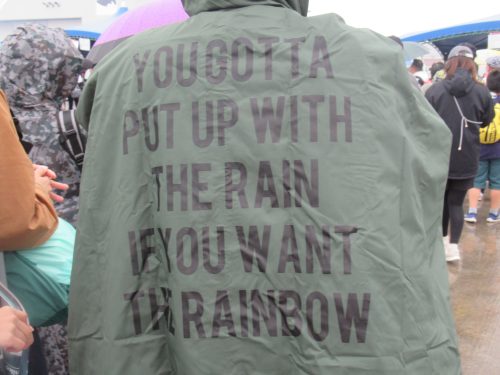
The rain might have put a damper on a majority of the air shows and the general atmosphere, but as a rebuttal to that claim, have a look at the quote on this man’s jacket I read when I was waiting in line for my brisket sandwich. There’s a silver lining in any cloudy sky, and today’s silver lining was the abundance of interactions between Japanese and American people that happened at MCAS Iwakuni. For US citizens living in this part of Japan, Friendship Day provided that much-needed desire for that taste of home when flying back is inopportune. Though the presence of US troops stationed in Japan is often a topic of debate, I for one and thankful that MCAS Iwakuni exists, and look forward to the rainbow that will be next year’s Friendship Day, rife with more air shows, nostalgic food, and fun moments with our neighborhood Marines.
Written by the Joy in Hiroshima Team
